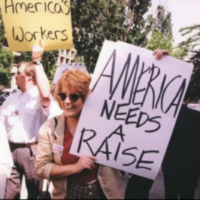On November 29, 2012, a group of 200 fast-food workers in New York City—fed up with low pay and roadblocks to organizing—walked out of their jobs demanding a $15 hourly wage and a union. At the time, The New York Times described the strike as “the biggest wave of job actions in the history of America’s fast-food industry.”[1]
That “biggest wave of job actions,” led by Black workers and other workers of color, would not stay contained to the fast-food industry for long. Over the course of the decade that followed, the Fight for $15—as the movement inspired by the strikes would come to be known—spread from coast to coast, animating workers across industries to join the demand for higher wages.
To date, 29 states and nearly five dozen cities and counties have raised their wage floors since 2012—many to $15 an hour or more. In addition, employers of all sizes—including some of the world’s largest corporations employing tens of millions of workers—have been inspired or compelled to raise their pay scales.
As a result, since 2012, more than 26 million workers have won higher pay to the tune of $150 billion.[2] Nearly half (46 percent) of the benefiting workers are workers of color, whose additional earnings amount to slightly over 50 percent ($76 billion) of the estimated higher pay. In addition to higher pay, the Fight for $15 has brought workplace justice issues to the forefront and inspired worker organizing more broadly.
Since 2012, more than 26 million workers have won higher pay to the tune of $150 billion.
To commemorate the landmark 10-year anniversary of the Fight for $15, this report analyzes the movement’s impact beyond wages. We focus on three measures: the movement’s impact on the racial wealth gap (as measured by comparing the median net worth of white workers versus workers of color), its impact on unions (as measured by membership, coverage, and median hourly wages), and its impact on the overall economy (measured by the multiplier effect).
We find that:
- With regard to the median net worth and the racial wealth gap:
- Between 2013 and 2019, worker wealth grew faster in states that adopted a minimum wage higher than the federal rate (74 percent increase, on average) compared to states that applied the federal rate (55 percent).
- The increase in personal net worth was particularly strong for Black (174 percent) and Latinx workers (211 percent) in states that raised their minimum wages, and even more so for Black and Latinx workers in states on a path to $15 or more (186 percent and 233 percent, respectively).
- Although the racial wealth gap persists today, our analysis finds a strong association between the emergence of the Fight for $15 and the narrowing of the racial wealth gap. In higher-wage states, the Black-white wealth gap decreased by 40.3 percentage points during the period analyzed, and the Latinx white wealth gap decreased by 29.4 percentage points. In states on a path to $15 or more, the Black-white and Latinx-white gaps decreased faster: by 54.3 and 48.0 percentage points, respectively.
- Recent studies by economists from the University of California, Berkeley[3] found that minimum wage increases have historically had equitable impacts. In addition, an analysis by the Federal Reserve of Cleveland shows that racial income disparities impact the wealth building of Black people over time and suggests that income policies should be a main means of addressing the racial wealth gap.[4]
- With regard to impacts on union membership, coverage, and pay:
- Between 2011 and 2021, union membership increased by 3.8 percent in states that raised their minimum wages but decreased by 9.9 percent in states that apply the federal minimum wage.
- When narrowing the analysis to workers who earn at least $15 per hour, union membership grew much faster (18.4 percent) in higher-wage states, while it decreased by 3.5 percent in federal-rate states.
- The median hourly wage of union members in higher-wage states increased more than three times as fast as their counterparts’in federal-rate states (16.7 percent compared to 5.2 percent).
- In 2021, the union wage premium was $7 per hour in higher-wage states, and $5.87 in federal-rate states.
- Assuming full-time, year-round work, that translates to approximately $15,000 in higher annual earnings for union workers in higher-wage states and $12,000 for union workers in federal-rate states.
- With regard to impacts on the economy:
- We estimate that minimum wage policies since 2012 led to $87.6 billion in annual economic output.
- That economic output supports an additional 452,000 jobs each year.
Download the full report to read more.
Endnotes
[1] Steven Greenhouse, “With Day of Protests, Fast-Food Workers Seek More Pay,” New York Times, November 29, 2012, https://www.nytimes.com/2012/11/30/nyregion/fast-food-workers-in-newyork-city-rally-for-higher-wages.html.
[2] Yannet Lathrop, T. Willian Lester, and Matthew Wilson, “Quantifying the Impact of the Fight for $15: $150 Billion in Raises for 26 Million Workers, With $76 Billion Going to Workers of Color,” National Employment Law Project, July 2021, 4, https://s27147.pcdn.co/wp-content/uploads/Data-BriefImpact-Fight-for-15-7-22-2021.pdf.
[3] See Jesse Wursten and Michael Reich, “Racial Inequality and Minimum Wages in Frictional Labor Markets,” Institute for Research on Labor and Employment, IRLE Working Paper No. 1, February 2021, https://irle.berkeley.edu/files/2021/02/Racial-Inequality-and-Minimum-Wages.pdf; and Ellora Derenoncourt and Claire Montialoux, “Minimum Wages and Racial Inequality,” Quarterly Journal of Economics 136, no. 1 (February 2021): 169–228, https://doi.org/10.1093/qje/qjaa031.
[4] Dionissi Aliprantis and Daniel R. Carroll, “What Is Behind the Persistence of the Racial Wealth Gap?,”
Federal Reserve Bank of Cleveland, February 2019, https://www.clevelandfed.org/newsroom-andevents/publications/economic-commentary/2019-economic-commentaries/ec-201903-what-isbehind-the-persistence-of-the-racial-wealth-gap.





